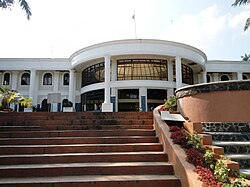Quirino | |
|---|---|
(from top: left to right) Part of Cagayan River in Quirino, Aerial view of Maddela, Quirino Provincial Capitol, Cordon-Diffun-Maddela-Aurora Road and Cabarroguis Town Hall | |
| Nickname: Forest Heartland of Cagayan Valley | |
 Location within the Philippines | |
| Coordinates: 16°17′N121°35′E / 16.28°N 121.58°E | |
| Country | Philippines |
| Region | Cagayan Valley |
| Founded | June 18, 1966 |
| Named after | Elpidio Quirino |
| Capital | Cabarroguis |
| Largest Municipality | Diffun |
| Government | |
| • Type | Sangguniang Panlalawigan |
| • Governor | Dakila Carlo E. Cua (PFP) |
| • Vice Governor | Julius Caesar S. Vaquilar (PDP–Laban) |
| • Representative | Midy Cua (Lakas–CMD) |
| • Legislature | Quirino Provincial Board |
| Area | |
• Total | 2,319.66 km2 (895.63 sq mi) |
| • Rank | 54th out of 81 |
| Highest elevation | 1,808 m (5,932 ft) |
| Population (2024 census) [2] | |
• Total | 210,841 |
| • Rank | 73rd out of 81 |
| • Density | 90.8931/km2 (235.412/sq mi) |
| • Rank | 72nd out of 81 |
| Demonyms |
|
| Divisions | |
| • Independent cities | 0 |
| • Component cities | 0 |
| • Municipalities | |
| • Barangays | 132 |
| • Districts | Legislative district of Quirino |
| Time zone | UTC+8 (PHT) |
| IDD : area code | +63 (0)78 |
| ISO 3166 code | PH-QUI |
| Spoken languages |
|
| Website | www |
Quirino, officially the Province of Quirino (Ilocano : Probinsia ti Quirino; Tagalog : Lalawigan ng Quirino), is a landlocked province in the Philippines located in the Cagayan Valley region in Luzon. Its capital is Cabarroguis while Diffun is the most populous in the province. It is named after Elpidio Quirino, the sixth President of the Philippines.
Contents
- History
- Early history
- Colonial era
- Establishment as a separate province
- Marcos dictatorship era
- Geography
- Climate
- Administrative divisions
- Barangays
- Demographics
- Languages
- Religion
- Economy
- Government
- References
- External links
The province borders Aurora to the southeast, Nueva Vizcaya to the west, and Isabela to the north. Quirino used to be part of the province of Nueva Vizcaya, until it became a sub-province in 1966, then it was separated in 1972.










